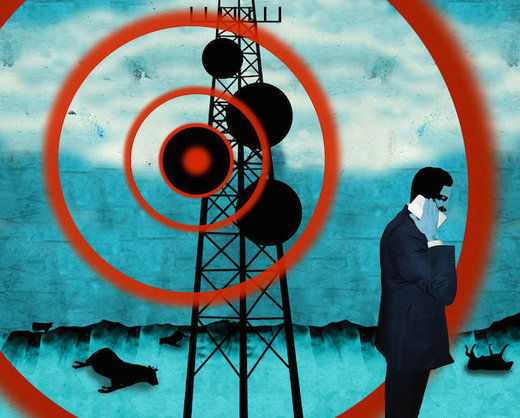RF-EMF radiation can cause damaged DNA, heat to the tissues and can disrupt the blood-brain-barrier. These are real-world effects, and ARPANSA is actively engaged in discussions with EHS community, medical specialists, and researchers. The agency will continue to examine research regarding the health effects of EMF radiation.
RF-EMF damages DNA
Exposure to man-made electromagnetic fields (EMFs) are associated with DNA damage, as well as other health adverse effects. EMFs can affect the intracellular ionic levels, which are crucial to maintain a cell's electrochemical balance. In turn, this can alter the balance of cell metabolism, resulting to DNA damage. Moreover exposure to EMFs can also trigger an overproduction of free radicals and reactive oxygen species (ROS).

The exposure to radiation from RF-EMF has been linked with alterations in the male germ cell's development. This results in the transformation of germ cells into spermatozoa, aswell as functional maturation as the spermatozoa pass throughout the epididymis. To investigate the effects of RF-EMF on male germ cells, a specifically-designed waveguide machine was designed to expose unrestrained mice to RF-EMF at 2.2 W/kg.
In a study that was conducted recently, researchers discovered that exposure to RF-EME caused the oxidation of DNA in spermatozoa. Sperm DNA fragmentation increased by 18% after an entire week of treatment and by 23 percent after 5 weeks. Furthermore, emf radiation in mitochondria was observed by measuring the level of a biomarker, 8-hydroxy-2-deoxyguanosine (8-OH-dG).
Despite this, RF-EMF radiation is not yet considered to be a carcinogen. But, numerous studies have found that exposure to RF-EMF radiation can damage DNA health in variety of cell lines. In one study, scientists exposed Vero cell lines to EMF at 100 Hz over 45 minutes. what is emf radiation measured DNA damage 48 hours after exposure to determine if exposure affected DNA integrity.
The effect of RF-EMF on tissue heating
Although the effects of RF EMF are typically considered as thermal in nature, a few studies have revealed that non-thermal effects are also observed. These effects may account for some of the unresolved observations in epidemiological studies on EMF hypersensitivity. It is therefore important to take into account non-thermal effects when conducting an exhaustive review.
The non-thermal effects of RF-EMF could be mediated by the cell membrane. This is an area of research that has been extensively examined. In particular the electrochemical properties of cell membranes is being studied. It is believed that RF-EMF energy higher than 1 MHz is transferred into the tissues through dielectric dissipation and ionic discharge. Studies of the theory have suggested that the energy that is transferred to tissues could be as high as 200 kV/m.
The electric properties of tissues are controlled through the distribution and composition of water molecules and other molecules inside the body. This determines how absorbent RF EMR is by different tissues. The tissues with the highest conductivity tend to absorb more field, and thus cause more of an impact. This is the reason the degree of heating in tissues doesn't increase continuously between the outside and inside the body and is only noticeable in hot areas. Bone and fatty tissue is less susceptible to heating by RF than other tissues, because they have a low water content.
The intensity of the field's electromagnetic energy is determined by the strength and frequency that the electromagnetic field has. Muscle tissue absorbs more field radiation than most tissues and converts it to heat more efficiently. Usually the depth of penetration of RF-EMF is measured in millimeters (mm). The higher the frequency, more shallow the penetration.
RF-EMF causes blood-brain barrier disruption
Researchers have discovered that RF-EMF could disrupt the blood-brain barrier which can alter sleep patterns and neurotransmitter levels. In addition the impacts of EMF on brain activity have been linked to neurodegenerative diseases. For example, EMF from mobile phones can alter electroencephalogram activity as well as sleep patterns, and the activities of nitric oxide and xanthin oxidase.
Researchers at Vienna University have studied the effects of exposure to RF-EMF on brain cells. emf radiation symptoms examined what effects ELF EMFs on the nervous system. Although the cellular mechanisms involved are not completely comprehended but there is a clear relationship between exposure to ELF EMF and depletion of myelin. This relationship might account for the electro-hypersensitivity symptoms of electro-hypersensitivity. However, there are tested methods to regenerate myelin within the brain.
Researchers have observed that exposure to the frequency of 900 Mhz EMF increased the permeability of BBB and raised the signs of neuronal injury in rodents. They also observed an increase in the release of neuronal albumin. Further, they found the following: after about 30 min of exposure to 900 MHz, 99mTc-MIBI increased its penetration into the brain. But, this effect did not happen with Evans blue-based injections.
However, RF-EMF is not able to provide a definitive mechanism to disrupt the BBB. Research suggests that EMF exposure can increase erythrocyte membrane permeability, which could affect the BBB and enhance the efflux of calcium-ion. Furthermore, the presence a 99mTcMIBI radiotracer inside the brain is also connected to an increase in the permeability and permeability of the BBB.
